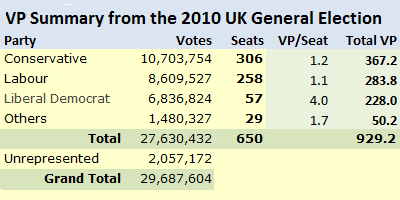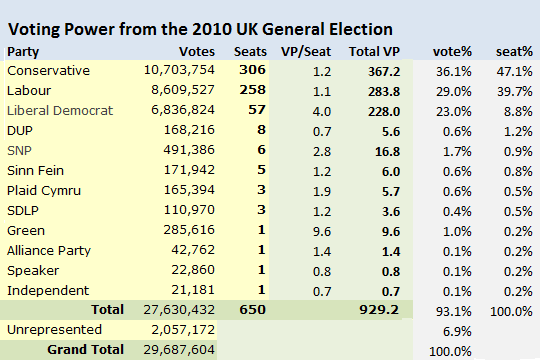T L Hurst
revised 28th Nov 2021
This paper suggests a way of improving the proportionality of representation in the House of Commons without changing the "First Past The Post" electoral system. The idea is to make the electors' votes cast in the general election for parties represented at Westminster of more equal value in parliamentary divisions.
There is a significant inequality in the UK parliamentary election system between the number of MPs that are elected per party and the percentage of electors who voted for those parties. So a referendum was held in the UK in May 2011 which proposed changing the "First Past the Post" electoral system to an Alternative Vote one. However, the proposal failed, and the more than two to one against result makes it unlikely that such a referendum will be repeated for a generation. Hence if we are to address this inequality, a solution is needed that does not require a change to the "First Past The Post" electoral system. This paper proposes such a system.
A significant merit of the FPTP system is that the electorate in each constituency vote for the candidate they want to represent them, without the complexity of alternative voting. This direct link between the MP and the voters who elected him/her encourages good constituency MPs who actively represent their constituents' interests in parliament. It is good for "grass roots" democracy.
It is also claimed that the FPTP system promotes stable government, as either of the two main parties can gain an overall majority in parliament with only a minority of the vote. However this is also a weakness in that they may lack a clear mandate from the electorate to implement their policies.
A major weakness of the FPTP system is that it disenfranchises the electorate who voted for candidates who did not win a seat. It is true that all the major parties put up candidates who are not elected, but there remains a large discrepancy between the average votes per seat won for the two main parties compared to the others:
This can be a disincentive for electors to vote, if they expect that their preferred candidate has no likelihood of winning a seat. It can also promote tactical voting, where electors vote to keep an opponent from winning the seat, rather than voting for their preferred candidate.
The primary merit of proportional representation is that it values votes more fairly. This is good for democracy as it encourages people to vote. It also encourages them to vote for their preferred candidate, rather than tactically.
The weaknesses of proportional representation include a lack of transparency, and in some cases, a reduced accountability. E.g. In an alternative voting system, it is not apparent to the electors at the time that they make their vote which of the candidates they choose will benefit from their vote. Whereas, a centralised list of candidates can weaken links between the MPs and the constituencies.

The voting power proposal retains the FPTP system to preserve the link between the MPs elected and the voters wishes. However, votes cast by MPs would be converted to voting power according to the average vote per seat of their party.
The voting power per seat is calculated as follows:
p = v / t * 1,000 / s
where:
p = voting power rounded to 1 decimal place (Conservatives = 1.2).
v = votes cast for the party (Conservatives = 10,703,754).
t = total votes cast in election (29,687,604).
s = seats won by the party (Conservatives = 306).
It is suggested that the voting power for each party's MPs remain unchanged by by-elections and other interim changes. In the case of a by-election won by a party not already represented in the house of Commons, the voting power should be derived using the calculation established at the general election.
It is likely that manual telling arrangements for division votes in parliament would need to be augmented by an electronic system. This could be in the form of voting panels in the house, or if the members wish to continue the tradition of voting by division, they could have digital ID cards, to identify them when a division take place. The system could attribute and total the appropriate voting powers, and could also provide audit facilities.
It allows the voting power of MPs in parliamentary divisions to reflect the electoral votes cast at the general election, for the parties that are represented in the House of Commons. It also reduces the inequalities caused by constituencies of different sizes, hence lessening the need for boundary changes.

An example of the voting powers that would have applied is included, based on the results of the 2010 general election, together with the voting powers of the respective parties. Note: The voting power of each MP is rounded to one place of decimals.
The paper can be downloaded in pdf format by clicking here.
The proposal leaves around 2 million voters at the 2010 general election unrepresented, as their votes were cast for parties that did not secure a seat.
Note: The author is not affiliated to any political party.